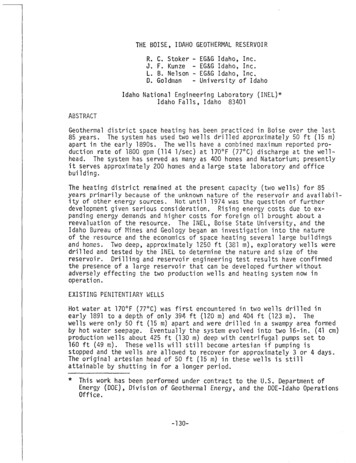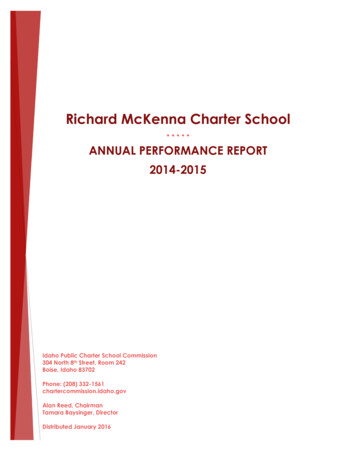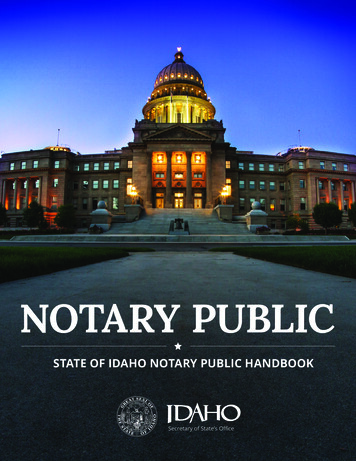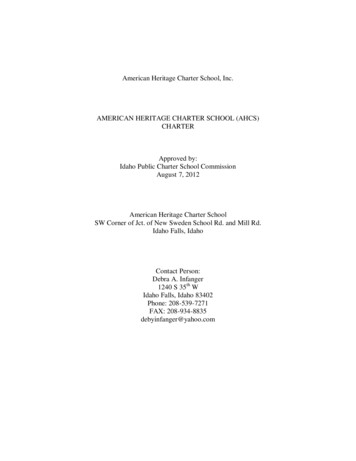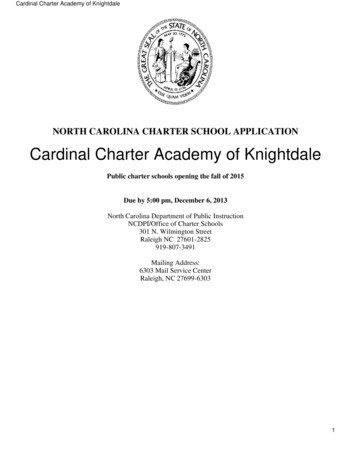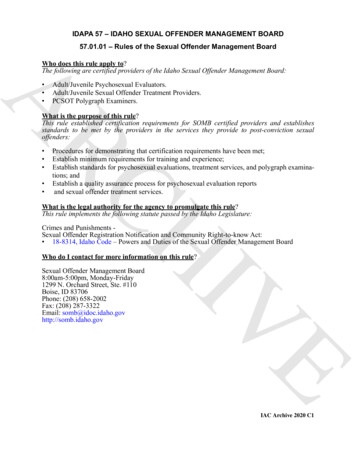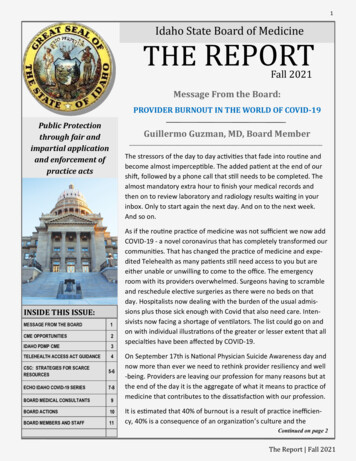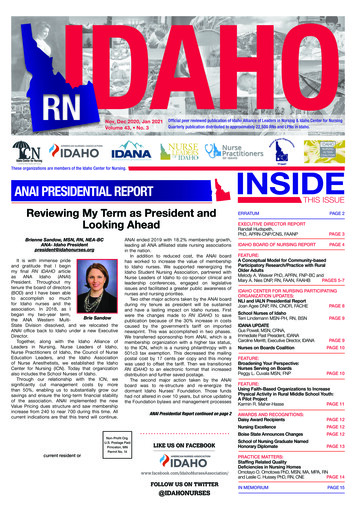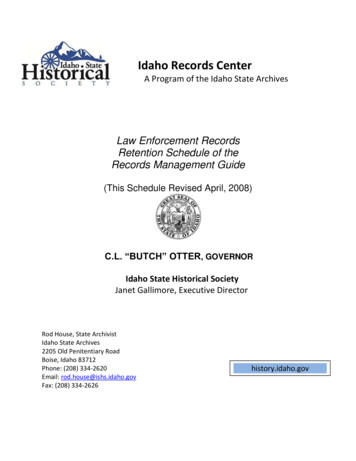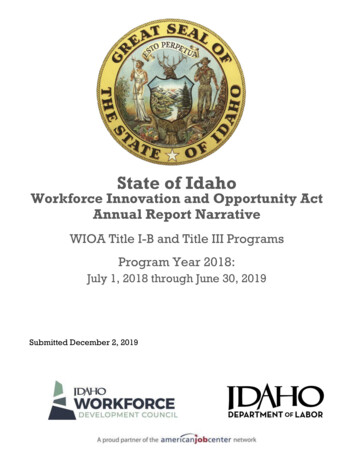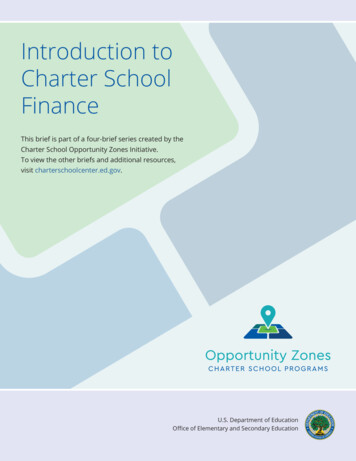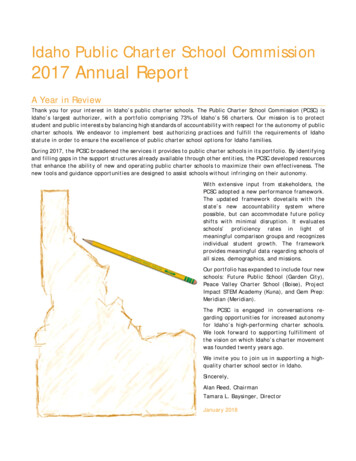
Transcription
Idaho Public Charter School Commission2017 Annual ReportA Year in ReviewThank you for your interest in Idaho’s public charter schools. The Public Charter School Commission (PCSC) isIdaho’s largest authorizer, with a portfolio comprising 73% of Idaho’s 56 charters. Our mission is to protectstudent and public interests by balancing high standards of accountability with respect for the autonomy of publiccharter schools. We endeavor to implement best authorizing practices and fulfill the requirements of Idahostatute in order to ensure the excellence of public charter school options for Idaho families.During 2017, the PCSC broadened the services it provides to public charter schools in its portfolio. By identifyingand filling gaps in the support structures already available through other entities, the PCSC developed resourcesthat enhance the ability of new and operating public charter schools to maximize their own effectiveness. Thenew tools and guidance opportunities are designed to assist schools without infringing on their autonomy.With extensive input from stakeholders, thePCSC adopted a new performance framework.The updated framework dovetails with thestate’s new accountability system wherepossible, but can accommodate future policyshifts with minimal disruption. It evaluatesschools’ proficiency rates in light ofmeaningful comparison groups and recognizesindividual student growth. The frameworkprovides meaningful data regarding schools ofall sizes, demographics, and missions.Our portfolio has expanded to include four newschools: Future Public School (Garden City),Peace Valley Charter School (Boise), ProjectImpact STEM Academy (Kuna), and Gem Prep:Meridian (Meridian).The PCSC is engaged in conversations regarding opportunities for increased autonomyfor Idaho’s high-performing charter schools.We look forward to supporting fulfillment ofthe vision on which Idaho’s charter movementwas founded twenty years ago.We invite you to join us in supporting a highquality charter school sector in Idaho.Sincerely,Alan Reed, ChairmanTamara L. Baysinger, DirectorJanuary 2018
Portfolio OverviewThe PCSC’s portfolio comprises 41 public charter schools. These schools are located all across the state, in bothrural and urban communities, and served approximately 16,800 students during the 2016-17 school year. Theirtime in operation ranges from one to nineteen years. They offer an array of educational choices: Core Knowledge,Expeditionary Learning, Montessori, Waldorf, International Baccalaureate, and more. Several are alternativeschools, and others focus on underserved or at-risk populations while welcoming all students who wish to attend.Eight are categorized as virtual schools, which together enroll about 4,900 students.PCSC PORTFOLIO SCHOOLYEARLOCATIONGRADESMETHODAlturas International AcademyAmerican Heritage Charter SchoolAnother Choice Virtual SchoolBingham AcademyBlackfoot Community Charter Learning CenterChief Tahgee Elementary AcademyCoeur d'Alene Charter AcademyCompass Public Charter SchoolConner AcademyFalcon Ridge Public Charter SchoolFuture Public SchoolGem Prep: MeridianGem Prep: PocatelloHeritage AcademyHeritage Community Charter SchoolIdaho Technical Career 820182016201120112014Idaho FallsIdaho FallsTreasure ValleyBlackfootBlackfootFort HallCoeur d'AleneMeridianPocatelloKunaGarden ternational BaccalaureateCore KnowledgeVirtual, Special NeedsSTEM, Postsecondary PrepBrain-Based, Multi-AgeNative Language & CultureCollege PrepCompass MethodHarborHarborSTEMBlendedBlendedSchoolwide EnrichmentClassical, Dual-LanguageVirtual, Career TechnicalIdaho Connects OnlineIdaho Science and Technology Charter SchoolIdaho Virtual AcademyINSPIRE Connections AcademyiSucceed Virtual High SchoolKootenai Bridge AcademyLegacy Charter SchoolLiberty Charter SchoolMonticello Montessori Charter eBlackfootStatewideStatewideStatewideCoeur -12K-6VirtualScience & TechnologyVirtualVirtualVirtualVirtual, Credit RecoveryHarborHarborMontessoriNorth Idaho STEM Charter Academy2012RathdrumK-12STEMNorth Star Charter SchoolNorth Valley AcademyPalouse Prairie Charter SchoolPeace Valley Charter SchoolProject Impact STEM AcademyRichard McKenna Charter SchoolRolling Hills Public Charter SchoolSage International School of BoiseSyringa Mountain SchoolTaylor's Crossing Public Charter SchoolThe Village Charter SchoolVictory Charter SchoolVision Charter SchoolWhite Pine Charter SchoolXavier Charter n HomeBoiseBoiseKetchumIdaho FallsBoiseNampaCaldwellIdaho FallsTwin 12K-8K-12International BaccalaureateCore KnowledgeExpeditionary LearningWaldorfBlended STEMMontessori K-8, Virtual Alt. HSHarborInternational BaccalaureateWaldorf InspiredHarbor7 Habits & LeadershipHarborClassicalCore KnowledgeClassical1
Who We AreThe PCSC’s seven members hail from all around the state. Commissioners are appointed by the Governor (3members), Senate Pro Tempore (2 members), or Speaker of the House (2 members). They serve four-year terms,and officers are elected every two years in the spring.Our mission is to ensure PCSC-authorized public charter schools’ compliancewith Idaho statute, protecting student and public interests by balancinghigh standards of accountability with respect for the autonomy of publiccharter schools and implementing best authorizing practices to ensure theexcellence of public charter school options available to Idaho families.Each commissioner adds to a broad scope of collective experiencein public education, business, and governance. All bring to the tablea strong desire to contributefor Idaho families.to quality school choiceThe PCSC’s FY 2018 budget is 665,600, representing an increase of34% from FY 2017. The legislature approved this increase in orderto facilitate the engagement of independent experts in the charterrenewal process. The PCSC’s revenue comprises a combination ofauthorizer fees and state funds appropriated as part of the Officeof the State Board of Education’s budget.The PCSC office is staffed by the Office of the State Board ofEducation and includes four FTE. In 2017, PCSC staff reorganizeditself to increase its capacity to develop services for publiccharter schools. These services include extensive pre-openingsupport for newly approved schools, as well as new resources forcharter school leaders and governing boards.Additionally, the PCSC and its staff worked with stakeholders torefine the charter renewal process.These effortsstreamlined the process, making it easier for schools to navigatewhile retaining the best practices that enable the PCSC to makeinformed, outcome-based decisions. Further development of theprocess will be undertaken in response to identified need.The PCSC also engaged stakeholders in the development of anupdated performance framework.Adopted in May2017, the new framework is designed to provide meaningful dataregarding the performance outcomes of schools within the contextof their student demographics, size, and educational models.The following pages of this report represent the initial data setgathered using the new framework. They offer new opportunities toconsider how charter school outcomes compare to those of theirsurrounding communities and impact students across the state.OUR COMMISSIONERSChairman Alan ReedIdaho FallsTerm: 2014 - 2018Vice-Chairman Brian SciglianoBoiseTerm: 2016 - 2020Commissioner Kelly MurpheyCastlefordTerm: 2014 – 2018Commissioner Wanda QuinnCoeur d’AleneTerm: 2016 - 2020Commissioner Sherrilynn BairFirthTerm: 2016 – 2020Commissioner Nils PetersonMoscowTerm: 2017 – 2019Commissioner Kitty KunzBoiseTerm: 2017 - 2019We also thank former CommissionerEvan Frasure for his service.2
What We DoAs an authorized chartering entity, the PCSC’s role is to protect students and taxpayers by overseeing the qualityof the charter schools it authorizes. We also endeavor to protect the autonomy of charter school boards, focusingon performance outcomes while giving schools as much freedom to direct their own inputs as the law allows.Authorizing work can be divided into three phases: petition review, ongoing oversight, and charter renewal. Eachof these phases demands a different focus, but our goals are always to encourage innovation and ensure quality.PetitionReviewThe petition review phase focuses on evaluating new charter petitions withthe following question in mind:Is it likely that this proposal will result in a successful, high-quality schoolthat fills a need in its community?Petition reviews consider: Quality of the educational program,Adequacy of financial resources, andCapacity of the founding board.Upon approval of a new charter petition, the PCSC and school sign aperformance certificate and framework detailing the academic andoperational performance expectations and measures against which the schoolwill be evaluated.OngoingOversightThe ongoing oversight phase focuses on keeping schools and stakeholdersapprised of schools’ performance outcomes relative to the standards containedin the performance certificate and framework.The PCSC provides its portfolio schools with annual performance reportsreflecting their academic, operational, and financial statuses. Schools areencouraged to use this information for strategic planning and to ensure thatany identified weaknesses are addressed in advance of renewal consideration.The PCSC endeavors to limit the reporting burden on its portfolio schools. Datacontained in annual performance reports is gathered primarily through ISEEand independent fiscal audits. Most PCSC portfolio schools need to submit onlya few, additional reports to the PCSC: CharterRenewalSemi-annual financial updates,An annual board membership update, andMission-specific performance data (optional).Charter renewal is an important process for both authorizers and schools. Atthe end of a school’s performance certificate term, authorizers must evaluateperformance outcomes in the light of contextual factors and determinewhether or not the school should continue to be entrusted with students’ timeand taxpayers’ resources for another five-year term. Schools are invited tomake their cases for renewal, demonstrating either strong performanceoutcomes or clear evidence that their outcomes, despite room forimprovement, still reflect success. This thoughtfully-applied bedrock ofaccountability is at the heart of the charter school concept.3
Services We ProvideDuring 2017, the PCSC broadened its provision of services to public charter schools. Portfolio schools weresurveyed to gather feedback on their greatest needs and preferred methods of resource delivery. We alsocoordinated with other state agencies, the Idaho School Boards Association, and the Idaho Charter SchoolNetwork to identify gaps in the supports already available. Based on this information, we developed resourcesdesigned to support our schools without infringing on the decision-making authority of their governing boards:New Charter Petitioner Guidance Although statute and administrative rule provide information regardingthe required contents of a charter petition, petitioners often request additional guidance regarding the scopeand nature of information their charters should include. This friendly guide walks petitioners through thedevelopment of a high quality charter petition in order to maximize their chances of approval.Pre-Opening Guidance The months between petition approval and opening day are busy and stressful for theleaders of a new public charter school. The PCSC’s pre-opening guidance includes interactive projectmanagement tools, resources and advice on topics ranging from employee recruitment to governance training,and a series of one-on-one meetings to exchange information and receive support from PCSC staff.New School Leader Orientation Many public charter schools hire administrators who have not previouslyworked in the charter sector. They face new challenges as they adjust to leading not only a school, but a charterLEA. The PCSC now offers written and in-person orientation materials to introduce new administrators to therole of the authorizer, charter-specific requirements, and resources available to support their work. Theorientation materials have also proven helpful to incoming charter school board members.Charter Renewal Guidance The PCSC provides ongoing guidance to schools whose charters will be consideredfor renewal in the upcoming year. From a one-on-one orientation meeting a year in advance, through optionalauxiliary data submission opportunities and an onsite visit by independent experts, the process is designed toensure that schools have the opportunity to share their perspectives regarding the success of their schools. Awritten Charter Renewal Guidance and Application document walks schools through the process, providingexamples and detail regarding the types of information that will help them present strong renewal applications.The PCSC looks forward to developing further resources in response to schools’ requests. These will include aninteractive, monthly Board Governance Guidebook and a series of webinars and self-guided exercises on topicssuch as branding, recruitment, and retention.Needs Schools IdentifyThroughout the course of its authorizing work, the PCSC seeks to enhance the operational autonomy that charterschools experience in exchange for the increased accountability represented by periodic renewals and theperformance framework. During 2017, our conversations with schools have emphasized the following needs:Reduced Reporting Burden Like many Idaho schools and districts, charter school leaders express a desirefor a reduction in the volume of paperwork due to state agencies each year.Increased Funding Flexibility Also like other schools and districts, charters often struggle with the confinesof funding silos, expressing that they could better serve their students if they were free to allocate funds asneeded.Increased Startup Funding Charter petitioners frequently encounter difficulty securing the startup fundsnecessary to ensure the stable opening of a new school. The absence of such funds can result in reliance onexpensive leases or high-interest loans, delayed opening, or even a petition denial recommendation.Other Funding Needs Operating schools need increased funding for facilities, teachers, and classified staff.4
Summary of 2017 Performance OutcomesThe following chart summarizes each PCSC portfolio school’s performance outcomes in the areas of academics,operations, and finance. Results are color-coded by schools’ accountability designations as detailed in theirindividual annual performance reports. The four accountability designations are Honor (blue), Good Standing(green), Remediation (yellow), and Critical (red). Gray indicates not applicable.PCSC PORTFOLIO SCHOOLACADEMICOPERATIONALFINANCIALCoeur d'Alene Charter AcademyFalcon Ridge Public Charter SchoolNorth Star Charter SchoolCompass Public Charter SchoolNorth Idaho STEM Charter AcademyLiberty Charter SchoolVictory Charter SchoolXavier Charter SchoolPalouse Prairie Charter SchoolVision Charter SchoolTaylor's Crossing Public Charter SchoolLegacy Charter SchoolAmerican Heritage Charter SchoolSage International AcademyAlturas International AcademyWhite Pine Charter SchoolRolling Hills Public Charter SchoolMonticello Montessori Charter SchoolConnor AcademyKootenai Bridge Academy (alternative)Richard McKenna Charter School (alternative)Idaho Virtual AcademyBingham AcademyIdaho Science and Technology Charter SchoolGem Prep: PocatelloIdaho Virtual Academy (alternative)Richard McKenna Charter SchoolINSPIRE Connections AcademyIdaho Technical Career AcademyNorth Valley AcademyHeritage Community Charter SchoolThe Village Charter SchoolIdaho Connects Online (alternative)Blackfoot Charter Community Learning CenterIdaho Connects OnlineiSucceed Virtual High SchoolSyringa Mountain SchoolAnother Choice Virtual SchoolHeritage AcademyChief Taghee Elementary Academy5
Academic OutcomesIn 2017, 54% of PCSC portfolio schools met or exceeded the academic standard established in the performanceframework. All 20 of these schools presently qualify for automatic or guaranteed renewal.Accountability designations of Honor, GoodStanding, Remediation, or Critical are basedon the percentage of the total availableacademic points that each school earns.Points are awarded for measures designedto reflect: Academic Accountability DesignationsISAT proficiency by comparison tothe state;ISAT proficiency by comparison tothe surrounding district;Student-level growth toward proficiency (K-8);Student-level growth by comparisonto academic peers (high school); &Graduation rate.Certain measures are modified oreliminated for alternative schools, virtualschools, and schools serving limited gradesets.CriticalRemediationGood StandingHonorWhile summary data can give us a sense of the overall performance of PCSC portfolio schools, each school’s storyis different. It is important to reserve judgement until one has visited the school, spoken to its educators andthe families they serve, and viewed the data in the context of the school’s mission and student population.Individual schools’ 2017 annual reports, which include comparative demographic data and other contextualinformation, may be found on the PCSC’s website.In 2017, the percentage of academic points earned by schools ranged from 15% to 94%, with a median of 61%.100%Percentage of Academic Points Earned80%60%40%Throughout This ReportExceeds StandardMeets Standard20%Does Not Meet StandardFalls Far Below Standard0%PCSC Portfolio Schools6
ProficiencyA school’s proficiency rate is the percentage of its students that achieved a rating of “proficient” or “advanced”on the Idaho Standards Achievement Test (ISAT). One way to evaluate the effectiveness of the PCSC’s portfolioschools is by comparing their proficiency rates to the state average.The following charts compare each PCSC portfolio school’s 2017 ISAT proficiency rates to the statewide averagefor students in the same grade set served by the public charter school.Difference from State Proficiency Rate in Math5040Percentage Points30Two-thirdsoftheseschools exceeded thestate average by 15 ormore percentage points.20100-10-20-30-40In math, 53% of PCSCportfolioschoolsexceeded the state averageproficiency rate for therelevant grade set.PCSC Portfolio Schools (excluding alternatives)Among the remaining 47%of schools whose mathproficiency rates fellbelow the state averagefor the relevant grade set,more than half fell shortby 15 or more percentagepoints.The extent to which virtual schools’ populations differ from those of most other types of schools is unknown.However, it is generally recognized that their student bodies tend to include somewhat higher percentages ofmobile, at-risk, and academically struggling students than the state as a whole. When only brick-and-mortarcharter schools are compared to their traditional counterparts statewide, the statewide comparative data shifts.Difference from State Proficiency Rate in Math(Brick & Mortar Only)50Percentage schools,PCSC Portfolio Schools (excluding virtuals and alternatives)exceededthe stateaverage inmath.7
Difference from State Proficiency Rate in ELA5040Percentage Points3020100-10-20-30-40PCSC Portfolio Schools (excluding alternatives)In English Language Arts,64% of PCSC portfolioschools exceeded thestateaverageproficiency rate for therelevant grade set.More than half of theseschools exceeded thestate average by 15 ormore percentage points.Among the remaining36% of schools whoseELA proficiency ratesfell below the stateaverage for the relevantgrade set, about onethird fell short by 15 ormore percentage points.Difference from State Proficiency Rate in ELA(Brick & Mortar Only)76% of40Percentage Pointsbrick-andmortarschoolsexceededthe stateaverage inELA.503020100-10-20-30-40PCSC Portfolio Schools (excluding virtuals and alternatives)Communities across Idaho vary widely, and comparisons to state averages can’t tell the wholestory of a charter school’s success. The PCSC also considers how its portfolio schools’ outcomes compare withthose of their surrounding districts. This allows each school to be evaluated in the context of a community whosedemographics – from ethnicity to mobility to socioeconomic factors – are typically more similar than those of theentire state.As in the state comparisons above, PCSC portfolio schools are compared to the surrounding district average forthe same grade sets they serve. Because virtual schools serve students across multiple districts or statewide,they are excluded from the district comparison charts that follow.8
Difference from Surrounding District Proficiency Rate in Math5040Percentage Points3020100-10-20-30PCSC Portfolio Schools (excluding virtuals and alternatives)Difference from Surrounding District Proficiency Rate in ELA5040Percentage Points3020100-10-20-30PCSC Portfolio Schools (excluding virtuals and alternatives)75% of PCSC portfolio brick-and-mortar schools had math proficiency rates thatexceeded those of their surrounding districts.80% had ELA proficiency rates that exceeded those of their surrounding districts.9
Virtual schoolsVirtual charter schools’ proficiency rates in mathranged from 22 percentage points above thevirtual school average to 22 percentage pointsbelow the average.Difference from Average Virtual SchoolProficiency Rate in Math30Percentage Pointstypically serve studentbodies whose demographics are more similar toone another than to individual districts or thestate. While most of Idaho’s virtual charterschools are authorized by the PCSC, these chartsinclude one, district-authorized virtual school(indicated by the gray bars).20100-10-20-30Virtual schools’ ELA proficiency rates ranged from18 percentage points above average to 26percentage points below average.engage inconversation and data collection toPCSCcontinuesDifference from Average Virtual SchoolProficiency Rate in ELAtobetter understand to what extent factors such asstudent mobility and off-cohort enrollmentimpact virtual school populations.In the meantime, stakeholders are invited to viewindividual virtual schools’ annual reports,available on the PCSC’s website, to learn moreabout their missions, student demographics, andacademic outcomes.30Percentage PointsTheVirtual Charter School (excluding alternatives)20100-10-20-30Alternative Math ProficiencyVirtual Charter School (excluding alternatives)Alternative schoolsalso serve significantly different demographics than the state as awhole.In 2017, the four alternative schools in the PCSC’sportfolio, all of which are virtual, had proficiencyrates that trended above those of the statewideaverages for alternative schools.Alternative ELA ProficiencyAmong top 10% of alternative schools statewideAbove average but below top 10%Below average but above bottom 20%Among bottom 20% of alternative schools statewideAll four alternative schools showed above average studentlevel growth in ELA. Two exceeded the standard in mathgrowth, while two did not meet the standard.10
Student-Level GrowthThe PCSC also assesses its portfolio schools on the basis of individual student growth. A criterion-referencedgrowth measure looks at the percentage of students in grades K-8 who are growing at a rate sufficient to reachproficiency within three years or by 10th grade, whichever comes first. Schools with at least 70% of studentsshowing adequate growth receive a “meets standard” or higher rating on the performance framework.Percentage of K-8 StudentsMaking Adequate Growth in MathIn 2017, 50% of brick-andmortar schools in thePCSC’s portfolio met orexceeded the standard inmath.10090Percentage8070Another 20% came withinten percentage points ofmeeting the standard.605040302010PCSC Portfolio Schools (excluding alternatives)Eightbrick-and-mortarschools, in addition to thefour virtual schools servinggrades K-8, fell far belowthe standard in math. Inthese cases, fewer than 50%of students were makingadequate growth.Percentage of K-8 StudentsMaking Adequate Growth in ELA100Another 20% of brick-andmortar schools, plus twovirtual schools, came withinten percentage points ofmeeting the standard.Threebrick-and-mortarschools and one virtualschool fell far below thestandard in ELA.908070PercentageTwo-thirds of brick-andmortar schools in thePCSC’s portfolio met orexceeded the standard inELA.605040302010PCSC Portfolio Schools (excluding alternatives)11
High schools in the PCSC’s portfolio are evaluated using a norm-referenced growth measure. This measurecompares the growth of individual students to that of their academic peers. It examines growth from grade 8 tograde 10. For example, charter school tenth graders who scored “below basic” in 8th grade are compared to otherstudents statewide who also scored “below basic” in 8th grade, while students who scored “proficient” arecompared to other students who scored “proficient.” The charts below reflect median student growth percentiles.Brick-and-Mortar Schools' Median SGP in MathPCSC Portfolio Schools' Median SGP in MathGrade 8-10Median SGP1001009080070Median SGP5060PCSC Portfolio Schools(excluding virtuals and alternatives)50403020100PCSC Portfolio Schools (excluding alternatives)Among brick-and-mortar high schools in the PCSC’s portfolio, 77% met or exceeded the standard in math and 84%met or exceeded the standard in ELA, with median SGPs above the 43rd percentile. Virtual schools’ median SGPsgenerally fell between the 30th and 42nd percentile, though two virtual schools did meet the standard in ELA.1009080Median SGP70100Median SGPPCSC Portfolio Schools' Median SGP in ELAGrade 8-10Brick-and-Mortar Schools' Median SGP in ELA500PCSC Portfolio Schools(excluding virtuals and alternatives)6050403020100PCSC Portfolio Schools (excluding alternatives)12
Graduation RatesGraduation rates at Idaho’s publicschools are calculated using a fouryear-plus-summer Adjusted CohortGraduation Rate (ACGR).PCSC Portfolio 4-Year ACGR (2016 Cohort)100%80%40% of high schoolsin the PCSC’sportfolio hadgraduation rates thatexceeded the stateACGR60%40%20%0%-20%-40%-60%PCSC Portfolio Schools (excluding alternatives)average by 15percentage points ormore.80%Alternative virtuals graduated anadditional 4% to 11% of students.60%40%20%0%PCSC Portfolio Schools(excluding virtuals and alternatives)4 Year ACGRState of IdahoDifference from StateIncrease from 4-year to 6-year ACGRat Virtual Charters (2015 Cohort)100%80%ACGR2015 cohort data indicates that nonalternative virtual schools graduatedan additional 0% to 16% of studentsbetween a four-year and six-yearcohort.Difference from State100%Virtual school leaders indicate thatmany students who enroll at virtualschools are already behind theircohorts. Some of their students areable to graduate in five or six years,rather than the traditional four.Additional research and conversationare underway to examine how manystudents are credit deficient whenthey enroll at virtual schools, how farbehind cohort they are, and the rateat which they recover credits afterenrollment.State of IdahoPCSC Brick-and-Mortar Portfolio 4-Year ACGRACGRBoth alternative and non-alternativePCSC-authorized virtual charterschools had low four-year ACGRs,ranging from 21% to 49%. (Idahooffers one other virtual charterschool, whose ACGR was 67%.) Thestate average ACGR was 80%.4 Year ACGR60%40%20%0%PCSC Portfolio Virtual Schools(excluding alternatives)4 Year ACGR5 Year ACGR6 year ACGR13
SAT Results and Go-On RatesSAT results offer additional perspective regarding schools’ academic outcomes. The following charts compareSAT results for PCSC portfolio schools to those of the state. The data reflects all 11th and 12th grade students whotook the SAT during the 2016-17 school year; participation was not required. It is important to note that theState category reflects a much larger sample than the PCSC Portfolio category. The left axis refers to medianscore, while the right axis refers to the percentage of students whose scores indicate college readiness.SAT Math 2017(Median Score & Percent College 550020%49510%490StateAll PCSC Portfolio Schools0%2017 Percent College ReadySAT Reading & Writing 2017(Median Score & Percent College 020%49510%490StateAll PCSC Portfolio Schools0%2017 Percent College ReadyThe state’s 2016 cohort Go-On rate was 49%. The rate for PCSC portfolio schools was 47%.14
Operational & Financial OutcomesThe PCSC assesses its portfolio schools on a range of management and compliance outcomes. We also reviewschools’ near-term financial health and long-term viability, bearing in mind that Idaho’s public charter schoolsreceived 118,965,210 in state funding during FY 2017. 90,176,645 was disbursed to PCSC portfolio schools.As in prior years, most PCSC portfolio schools demonstrated operational and fiscal strength. When weak areasdid appear, they tended to be in the areas of late reporting and independent financial audit findings. A smallminority of schools evidenced fiscal distress. In these cases, the PCSC has taken steps to protect taxpayerresources while allowing the schools every opportunity to regain stability.Student DemographicsThough all students are welcome to attend Idaho’s public charter schools, these schools do tend to be lessdemographically diverse than the state’s traditional public schools.Despite notable exceptions, most PCSC portfolio schools enroll smaller percentages of non-white students,students with lim
Idaho Connects Online 2009 Statewide 6-12 Virtual Idaho Science and Technology Charter School 2009 Blackfoot 4-8 Science & Technology . White Pine Charter School 2003 Idaho Falls K-8 Core Knowledge Xavier Charter School 2007 Twin Falls K-12 Classical . 2. Who We Are . The PCSC's seven members hail from all around the state. Commissioners .
